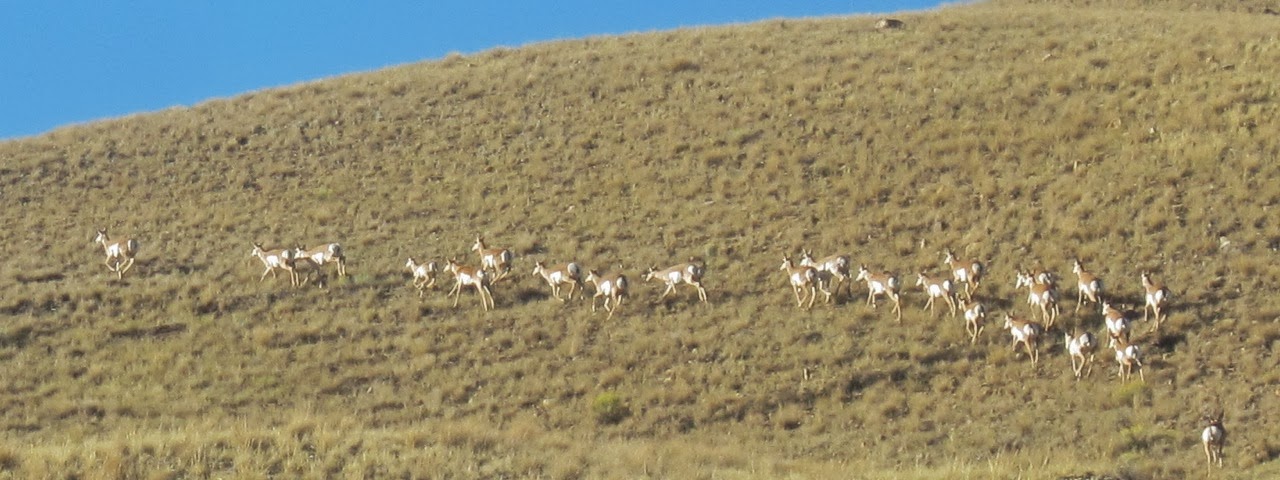MILES CITY– Recent surveys across Montana Fish, Wildlife and Parks (MFWP) Region 7 indicate that antelope populations are recovering but remain well below long-term averages. Wildlife biologists completed seven population trend surveys across the region and observed 1,867 antelope; similar numbers to last year. Overall antelope numbers across the region remain 50% below long-term average and 66% below the ten year peak count that occurred in 2006.
Four trend areas displayed an increase in antelope numbers (ranging from 6-73% higher), as compared to 2012; while 3 displayed moderate declines (ranging from 13-27%). Compared to 2012, region wide adult numbers observed declined 17%. Adult buck and doe numbers observed increased on three trend areas and declined on four trend areas. Region wide fawns observed increased 50% over last year. On six of seven trend areas fawn numbers increased; on four of those, fawn numbers more than doubled. On the seventh area observed fawns declined 5%. Excellent fawn production this year, coupled with good yearling recruitment is indicative of antelope populations showing positive signs of recovery.
In response to decreased populations, harvest opportunity since 2011 has been substantially reduced. Again this fall, 3,000 either sex and 100 doe fawn antelope licenses were issued region wide; an 87% reduction from 2009 when 13,000 either-sex and 10,000 doe-fawn licenses were issued. Of a total harvest of 1,537 antelope in 2013, only 245 doe antelope were harvested in the region compared to a long term average doe harvest of 4,600. “We were about as restrictive as possible with doe harvest last season,” said John Ensign, Region 7 Wildlife Manager.
Contributing to a slow recovery of southeastern Montana antelope populations, wildlife biologist Bernie Hildebrand suspects that a bluetongue outbreak in 2008 and the severe winter of 2010-11 rendered a significant portion of the doe population in northwestern Region 7, hunting districts (HD) 700 and 701 barren. In 2012, Hildebrand was seeing large groups of does with few or no fawns. “That’s not normal,” he stated. Using annual production and recruitment data, Hildebrand estimated that 35% of adult does in northwestern Region 7 were no longer producing fawns. “Fawn-to-doe ratios are expected to increase as that barren segment is harvested or dies out and is replaced by younger more productive does,” said Hildebrand. This appears to be occurring as fawn to doe ratios have increased from 20-53 fawns per 100 does last year to 89-94 fawns per 100 does this year.
Antelope population status varied across the region and so will hunting opportunities. “The highest antelope density was observed near Alzada,” stated Ensign. “Biologists observed about 60-80 bucks per 100 does in southern Carter County (HD 705), and fawn production was excellent in the area with 80-112 fawns per 100 does. “Populations are rebounding nicely in the southern portion of the region,” said Ensign. “We recommend hunters come to this part of the region to hunt antelope this fall.”
Glendive area biologist Melissa Foster observed healthy increases across HD703 and the northern portion of HD705. “Populations in my area have generally recovered to long-term averages, and I’m seeing good fawn production. There is certainly opportunity to hunt antelope but sportsmen who are unfamiliar with the area should be aware that it’s not our most productive antelope country. Although we’ve recovered to long-term average densities, an average density here would be a really low density in better antelope habitat elsewhere in Region 7. We simply don’t have the big expanses of sagebrush habitat that sustain antelope during winter like other parts of the region.”
Populations in the northwestern portion of the region (HD 700 and 701), which were impacted by a bluetongue outbreak in 2008 and most severely impacted by the 2010-11 winter remain in the toughest condition. “Although populations are increasing some, sportsmen need to be aware that counts in the Forsyth area, which has historically been a favorite antelope hunting destination, remain well below long term average,” according to Steve Atwood, Forsyth area wildlife biologist. “There are still antelope in that country, but better populations, higher buck-to-doe ratios , and more productive hunting may be found as you progress south and east in Region 7. “ One positive population index that was identified through recent survey efforts is that the doe-to-fawn ratio was at an all-time high for the area. Atwood predicts, “with excellent habitat conditions we’re seeing right now the stage is set for the antelope in the Forsyth area to rebound.”
Those interested in learning more about antelope populations or hunting opportunities in Region 7 should contact the regional office at (406) 234-0900 or specific area wildlife biologists.

(Report by Montana FWP; Photo via ecorover.blogspot.com)